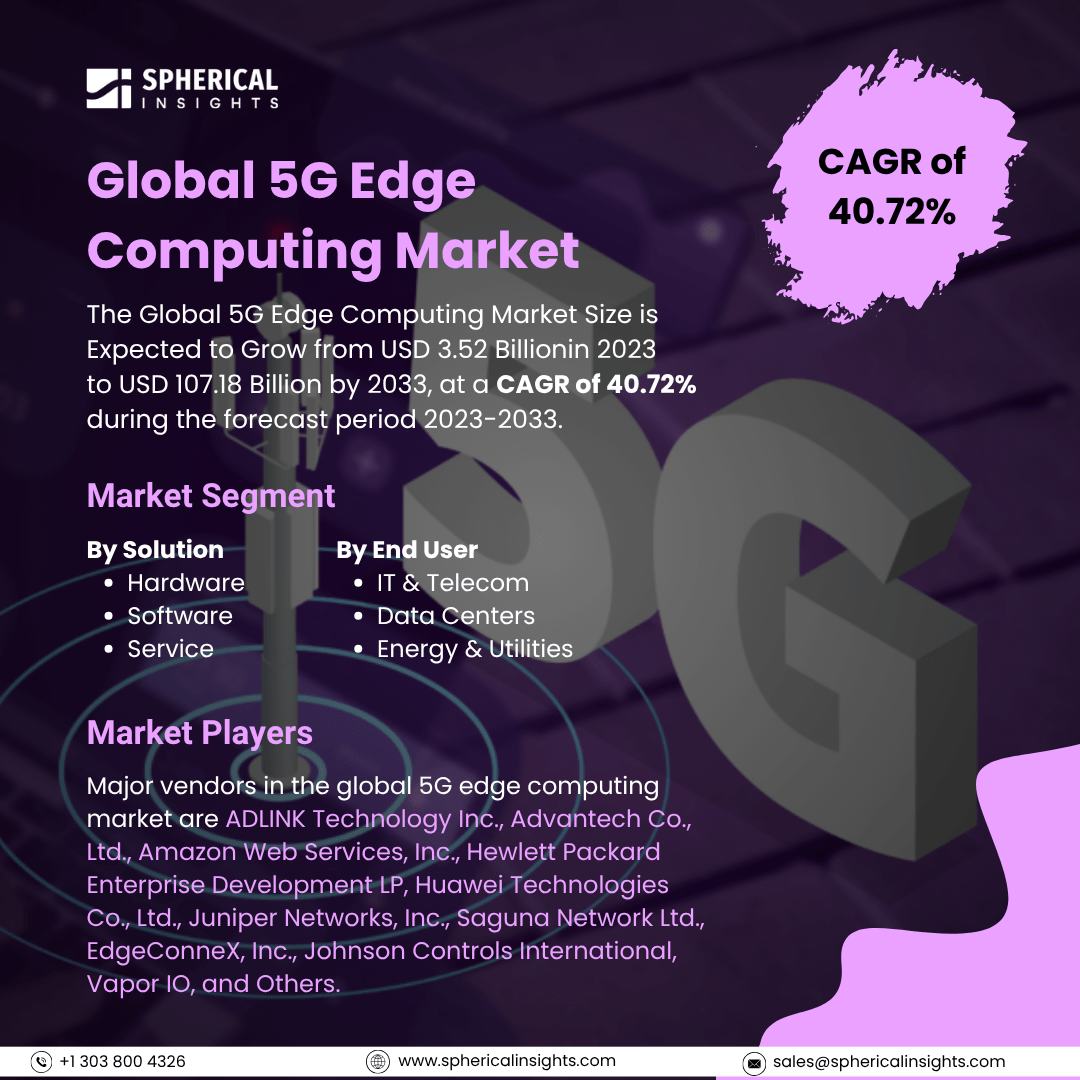Global 5G Edge Computing Market Size To Exceed USD 107.18 Billion By 2033
According to a research report published by Spherical Insights & Consulting, The Global 5G Edge Computing Market Size is Expected to Grow from USD 3.52 Billion in 2023 to USD 107.18 Billion by 2033, at a CAGR of 40.72% during the forecast period 2023-2033.
Browse 210 market data Tables and 45 Figures spread through 190 Pages and in-depth TOC on the Global 5G Edge Computing Market Size, Share, and COVID-19 Impact Analysis, By Solution (Hardware, Software, and Services), By End User (IT & Telecom, Data Centers, and Energy & Utilities), and By Region (North America, Europe, Asia-Pacific, Latin America, Middle East, and Africa), Analysis and Forecast 2023 – 2033
The global 5G edge computing market refers to the industry as the combination of edge computing technology and 5G networks, allowing data processing nearer the source and minimizing latency. For sectors that depend on rapid, dependable data processing, this connection improves efficiency, speed, and overall performance by improving real-time applications, including IoT, AI, and smart cities. Key driving factors for the growth of the 5G edge computing market include the increasing demand for more rapid transmission, lower latency, and real-time data processing. The market is expanding, though, because of the rapid advances in IoT and AI, and growing demand for low-latency services. The demand for more effective, decentralized computing solutions is being supported by the development of IoT devices, AI applications, smart cities, and driverless cars, in addition to developments in 5G infrastructure. However, regulatory obstacles, network coverage constraints, and high initial infrastructure costs limit the market for 5G edge computing.
The software segment accounted for the largest revenue share in 2023 and is projected to grow at a significant CAGR during the forecast period.
On the basis of the solution, the global 5G edge computing market is divided into hardware, software, and services. Among these, the software segment accounted for the largest revenue share in 2023 and is projected to grow at a significant CAGR during the forecast period. The segment growth is attributed to increasing demand for network orchestration, edge computing platforms, and security software that improve security, reduce latency, and optimize performance for real-time Internet of Things applications in 5G environments.
The IT & telecom segment accounted for the largest market share in 2023 and is anticipated to grow at a remarkable CAGR during the forecast period.
On the basis of end user, the global 5G edge computing market is divided into IT & telecom, data centers, and energy & utilities. The IT & telecom segment accounted for the largest market share in 2023 and is anticipated to grow at a remarkable CAGR during the forecast period. The segment growth is driven by the increasing demand for 5G connectivity, low-latency applications including AR and VR, and effective data processing to improve real-time decision-making and service delivery.
North America is anticipated to hold the largest share of the global 5G edge computing market over the predicted timeframe.
North America is anticipated to hold the largest share of the global 5G edge computing market over the predicted timeframe. The regional market growth is driven by the early deployment of 5G technology, the growth of the Internet of Things, and the dominance of significant sectors like IT, telecom, and healthcare. The region's sophisticated data processing requirements and demand for high-speed, low-latency applications encourage market expansion and innovation.
Asia Pacific is expected to grow at the fastest CAGR in the global 5G edge computing market during the forecast period. The regional market growth can be attributed to the development of 5G infrastructure, the growth of the Internet of Things, and the combination of cloud and edge computing. The market is expanding due to variables such as increased data generation, digital transformation, and the need for high-speed, low-latency solutions in industries including manufacturing and telecommunications.
Company Profiling
Major vendors in the global 5G edge computing market are ADLINK Technology Inc., Advantech Co., Ltd., Amazon Web Services, Inc., Hewlett Packard Enterprise Development LP, Huawei Technologies Co., Ltd., Juniper Networks, Inc., Saguna Network Ltd., EdgeConneX, Inc., Johnson Controls International, Vapor IO, and Others.
Key Target Audience
- Market Players
- Investors
- End-users
- Government Authorities
- Consulting and Research Firm
- Venture capitalists
- Value-Added Resellers (VARs)
Recent Development
- In February 2024, Broadcom, through its acquisition of VMware, launched advancements in its software-defined edge portfolio. These innovations aim to help telecommunications and enterprise customers modernize their networks and create new monetizable services.
Market Segment
This study forecasts revenue at global, regional, and country levels from 2023 to 2033. Spherical Insights has segmented the global 5G edge computing market based on the below-mentioned segments:
Global 5G Edge Computing Market, By Solution
- Hardware
- Software
- Service
Global 5G Edge Computing Market, By End User
- IT & Telecom
- Data Centers
- Energy & Utilities
Global 5G Edge Computing Market, Regional
- North America
- Europe
- Germany
- Uk
- France
- Italy
- Spain
- Russia
- Rest of Europe
- Asia Pacific
- China
- Japan
- India
- South Korea
- Australia
- Rest of Asia Pacific
- South America
- Brazil
- Argentina
- Rest of South America
- Middle East & Africa
- UAE
- Saudi Arabia
- Qatar
- South Africa
- Rest of the Middle East & Africa



